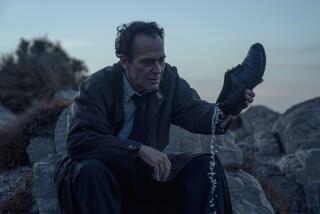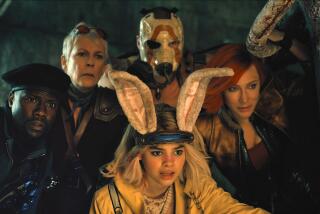Review: ‘Alice Through the Looking Glass’ is more blunder than wonder
“Alice Through the Looking Glass” is a movie for anyone who ever skimmed a passage of Lewis Carroll and thought, “This is great, but it could use a bit more ‘Terminator.’”
In Disney’s crass, pointless sequel to its similarly crass, pointless “Alice in Wonderland” (2010), our heroine doesn’t just tumble down a rabbit hole or step through a magic mirror. Availing herself of an early DeLorean prototype called the Chronosphere, Alice (played again by Mia Wasikowska) goes careening back and forth through time, embarking on a frenzied quest to save her friend the Mad Hatter (Johnny Depp) by plumbing his messy family history and correcting the mistakes of the past.
It’s a pity she doesn’t set the device for 2007: Perhaps she might have retroactively persuaded the director Tim Burton and the decision-makers at Disney to spare us the further desecration of a literary classic. Their live-action “Alice in Wonderland” was less an adaptation of its source material — which included both Carroll’s “Alice’s Adventures in Wonderland” (1865) and “Through the Looking-Glass, and What Alice Found There” (1871) — than an exercise in what the Mock Turtle memorably termed “Uglification.” A gloppy-looking 3-D eyesore weighed down by noisy action sequences and other soul-deadening focus-group notions of what kids want from their fantasy entertainment, the movie reproduced none of Carroll’s cleverness, imagination or mastery of language, or even the easygoing charm of Disney’s 1951 animated version.
Still, it was enough of a box-office hit to garner a follow-up, this time under the direction of James Bobin (who directed the two most recent “Muppets” movies). Burton’s devotees will be relieved to learn that, even in his absence, “Alice Through the Looking Glass” is a feast of garishly overwrought, effects-encrusted production design. Meanwhile, the returning screenwriter Linda Woolverton (best remembered for “Beauty and the Beast” and “The Lion King”) has again plundered elements from Carroll’s books and reshuffled them into a pedestrian narrative, replacing his sui generis nonsense with her own strenuously unimaginative and literal-minded storytelling.
Picking up more or less where its predecessor left off — and no, I couldn’t remember where, either — the film begins with Alice on the high seas, captaining her late father’s ship, the Wonder, through perilous waters in search of trade routes to China (reintroducing a perhaps unintended metaphor for the global challenges presently facing the movie industry). As played by Wasikowska with grown-up, no-nonsense seriousness, Alice is a trailblazing explorer and a Victorian-era role model: Decked out in the latest in 19th century Sino chic, she is beset on all sides by sneering men who want to either marry her or see her fail.
From there, the story quickly whisks Alice through the proverbial looking glass and back to Wonderland — or Underland, as it is inconsistently referred to here. Before long she is reunited with the ethereally ditzy White Queen (Anne Hathaway), the White Rabbit, the Cheshire Cat (Stephen Fry) and the imperious butterfly Absolem (occasioning a few poignant final line readings from Alan Rickman). Her old friends are happy to see her, as it seems only Alice can cure the Mad Hatter of his recent descent into catatonic depression.
As a rule, unless you’re Spike Jonze adapting Maurice Sendak, it’s not a great idea to turn your fantasy-world characters into moody therapy cases. “Alice Through the Looking Glass” is rarely more tiresome than when it’s probing the Hatter’s deep-seated daddy issues, which can’t help but feel like a tired holdover from familiar Burtonian territory (see, if you must: “Big Fish,” “Charlie and the Chocolate Factory”). Depp, again sporting multihued makeup and a Carrot Top wig, isn’t playing Mad so much as Morose as he tries — with simpering, sometimes nauseating results — to unlock the tragic clown within.
The Hatter isn’t the only one suffering the effects of some distant family trauma. There’s also the head-hungry Red Queen, played once more by Helena Bonham Carter with a witchy cackle and a severe case of computer-generated macrocephaly. We learn exactly how she and her younger sister, the White Queen, became lifelong enemies, in flashbacks to their checkered past that play like outtakes from “What Ever Happened to Baby Queen?” Of all the ways to bring Carroll’s characters to life on screen, is there anything more tedious one could do than try to explain them — to subject them to the tenets of modern-day psychoanalysis? What’s next? Humpty-Dumpty’s secret history of sexual deviance? “Tweedledum and Tweedledee: A Study in Codependency”?
The inconvenient truth of the original books is that they have never been particularly well suited to cinematic adaptation. As anyone who has spent hours poring over Martin Gardner’s marvelous “The Annotated Alice” knows, the two-part Alice narrative is less a traditional story than a brainy free-associative labyrinth — densely packed with puns, poems, parodies, allusions and riddles, and assembled with an almost architectural rigor and complexity (Carroll was, among other things, an accomplished mathematician).
Understandably, filmmakers have tended to seize on the fabulous images offered up by the author’s work, but the truest version of “Alice” would be a verbal achievement first and foremost, not a visual one. But even allowing for a less faithful, more free-form adaptation, “Alice Through the Looking Glass,” like “Alice in Wonderland” before it, represents a profound failure of imagination and a betrayal of the material’s spirit.
At every turn the filmmakers have simplified, banalized and sentimentalized Alice and her psychological landscape in ways that reek of ignorance at best and cynicism at worst. Watching these movies, you would never guess the Jabberwocky was the subject of one of the most linguistically inventive poems ever written; he’s just another forgettable, fire-breathing CGI beastie. And while it’s never unpleasant to spend time in Wasikowska’s company, the actress doesn’t seem to be playing a strong fantasy heroine so much as some vague, derivative concept of what a strong fantasy heroine should be.
As Alice flies between past and present, her chief nemesis — and eventually, her ally — is Time itself, played here as a sort of tyrannical, Teutonic-accented man-clock by Sacha Baron Cohen (who previously worked with Bobin on “Da Ali G Show”). The jab at German efficiency elicits a small chuckle, and your jaw might drop at the sight of Time’s castle — a massive mechanical enclave that brings the gears and pulleys of Martin Scorsese’s “Hugo” to mind and serves as a nicely gothic contrast to the film’s bright, gaudy colors. For a brief moment, time really does seem to stand still, and you may stop begrudging this misbegotten movie for wasting yours.
justin.chang@latimes.com
------------
‘Alice Through the Looking Glass’
MPAA rating: PG for fantasy action/peril and some language
Running time: 1 hour, 53 minutes
Playing: In wide release
MORE
Helena Bonham Carter brings her brand of formal oddity to ‘Alice Through the Looking Glass’
What exactly does the sound and fury of Bryan Singer’s ‘X-Men: Apocalypse’ signify?
Oscar Isaac gets his supervillain on for ‘X-Men: Apocalypse’
More to Read
Only good movies
Get the Indie Focus newsletter, Mark Olsen's weekly guide to the world of cinema.
You may occasionally receive promotional content from the Los Angeles Times.











